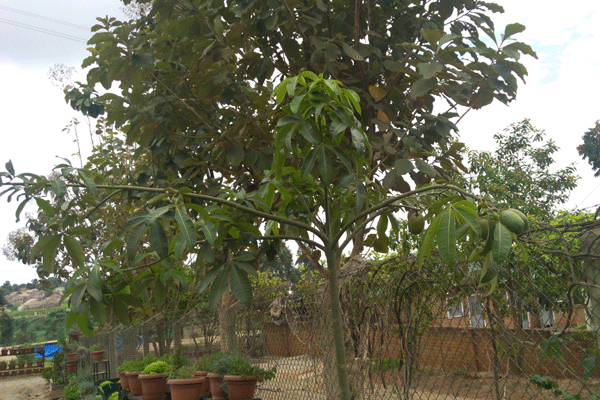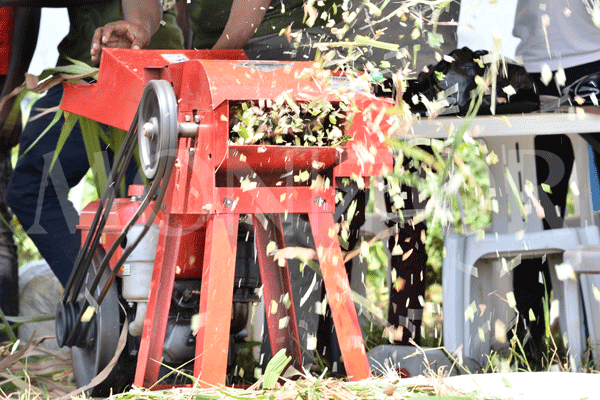Go nuts with Macadamia

A macadamia tree at the KCCA Demonstration Farm in Kyanja. PHOTO/ABDUL-NASSER SSEMUGABI
What you need to know:
- In the last decade, many farmers have increased the macadamia trees in their farms in a bid to enter the promising nuts agribusiness.
- Now Government of Uganda is adding Macadamia on the list of priority crops sending positive vibes to the farmers.
The macadamia nut tree is a fast growing evergreen tree with heavy dark green foliage originating from Australia.
Commercial production of the plant has since spread in areas such as Hawaii, Latin American countries, USA mainly in Florida and California and East Africa where farmers in Kenya and Uganda have adopted it.
Most farmers who have adopted commercial macadamia nut fruit farming use grafted seedlings but it can be grown directly from seeds.
The trees are usually vulnerable during the four years. However, after establishment, they can grow a continuous canopy that makes the trees less prone to pests and diseases.
In well managed systems, the trees will start bearing fruits at the fifth year but full production is usually attained from 12 -15 years. A good tree can produce for up to 40 years before a farmer may think of replanting.
Background
Mr Taddewo William Ssenyonyi, a coffee nursery operator based in Kakumiro is marketing macadamia seedlings to farmers. He explains that, “this is a wonder crop which has been adopted by farmers in the developed world for a long time. It is now being adopted in East Africa including Uganda because it has a commercial viability for farmers to earn income,” Ssenyonyi says.
Comparing it to cashew nut, he notes that Macadamia trees do not grow everywhere but farmers in East Africa have not experienced any challenges yet.
Its nut, once processed, is the most expensive with a quarter kilo of roasted nut sold at Shs40,000 or more.
AMAFH Farms located at Nambaale Village in Mityana District in Central Uganda grows the trees on a commercial scale as well as seedling multiplication.
Each seedling is sold at Shs12,000 and a farmer requires about 1,000 seedlings for an acre.
A tree that has grown for five years is capable of producing about 20kg of fruits while the tree that has lasted 15 years in the field will produce 70kg or more fruits.
Variety Selection
There are basically two major types that originate from Australia; the smooth-shelled Queensland nut called M. integrifolia and the rough-shelled nut, M. tetraphylla. However, there are number of varieties some of which are hybrids bred from the two species.
Propagation
This is a self-pollinating tree that does not produce directly from seed. While a farmer may start with seed, it could take more than 10 years for the tree to mature and it may or may not fruit.
It is the reason most farmers or nursery operators start with grafted plants to jumpstart the process and cut the maturity time in half.
Nursery operators are expected to have mother gardens on their farms from which they can cut out vines which must grow for 8-10 months to act as root stalks. These seedlings will be used for the grafting process.
Once they have been left to grow for the same period in nursery bed, they are now ready for planting in the fields.
Land preparation
It is important to till the land 12 months after clearing the bush. A farmer is expected to till the land for the second time at the onset of the rainy period to prepare for planting.
Macadamia has a root system comprised of compact root clusters that take up nutrients with great efficiency. A farmer is therefore expected to test the soil nutrient and ensure it contains pH approximately 5.5 to 6.
A farmer who can afford is expected to apply NPK fertilizer to soils that have less nutrients.
Planting
Farmers are expected to plant by the onset of the rain season. If a farmer is growing a tree from seed, nurture it until the plants have leaves and a stem that is roughly six inches tall.
While a farmer may grow just one tree, macadamia is known for low yields, unless steps are taken to increase pollination then the yield will be as expected.
This means farmers must use quality grafted seedlings and ensure that there are other flowering trees around the farm to attract beneficial insects
Transplant your homegrown or store-bought seedling to the yard, placing it into deeply worked soil. Be sure to maintain the same planting depth as the seedling experienced in the pot, for a smooth transition.
Usually farmers are encouraged to grow the trees with other food crops such as beans, groundnuts and green vegetables. The desired spacing is 7.5m by 7.5m accumulating about 75 trees per acre.
Macadamia has two planting seasons in a year that is June to August and from March.
The most crucial requirement for macadamia, especially in the seedling stage, is abundant water that drains well. A mature tree can use up to 350 litres of water every week in hot, dry weather.
Farmers are expected to water freshly sown plants deeply, tamping down the soil a second time to remove any remaining air in the holes and maintain evenly moist soil until the plant begins to grow. Then, in the absence of a drenching rain, water weekly all year-round.
Healthy
Like most other nuts, Macadamia nuts are rich in nutrients and beneficial plant compounds. Macadamia nuts are mostly eaten as flavoured snacks. They are also linked to several health benefits including improved digestion, heart health, weight management and blood sugar control. Globally, macadamia growth has increased by 50 per cent in the past decade, accompanied by strong price growth.
Now Government of Uganda is adding Macadamia to the list of priority crops. This was revealed by the Minister of Agriculture, Animal Industry and Fisheries Vincent Bamulangaki Ssempijja while visiting Macadamia farmers at in Mityana District.
He said a farmer can earn between Shs60-70m from an acre per year if properly managed.
“We are now looking for partners. We are making it a priority crop and we need farmers who can grow it on a large scale, because the market is available Worldwide,” the Minister said.
Macadamia varieties
Beaumont: ‘Beaumont’ is a hybrid from Australia, a cross between M. tetraphylla and M. integrifolia. It has a growth habit that is more upright than spreading. The blossoms are an especially showy pink and the nuts are medium to large in size. The fruiting season is long, but it is not uncommon for some nuts to crack and spoil before falling. This cultivar is highly recommended for the home gardens.
Cate: M. tetraphylla Cate originated in California. This rough-shelled cultivar is an aggressive grower with a thin shell and more frost hardiness. The fruiting season is short, with medium to large nuts. This is a self-harvesting variety.
Dorado: ‘Dorado’ originated in Hawaii and has an upright growth habit and medium height. It is known for producing an abundance of nuts in as few as five years.



